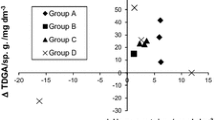Abstract
In mice kept on a diet with no vitamin B1, the total content of thiamine in the brain decreased, and muscle contractions evoked by stimulation of the nerve in phrenico-diaphragmatic preparations obtained from such animals became weaker. The measurements were performed in Krebs solution with a decreased content of Ca2+ and increased concentration of Mg2+; values of the developed force were normalized with respect to those in normal Krebs solution. Thus, B1 hypovitaminosis results in a decrease in the efficacy of neuromuscular synaptic transmission. Some neurological symptoms typical of a deficiency of vitamin B1 in the organism can be related to this effect.
Similar content being viewed by others
References
D. Lonsdale, “A review of biochemistry. Metabolism and clinical benefits of thiamin(e) and its derivatives,” eCAM (doi: 10.1093/ecam/nek009), 3, No. 1, 49–59 (2006).
A. Ya. Malyarevskaya, Metabolism in Fishes under Conditions of Anthropogenic Eutrophyzation of Reservoirs [in Russian], Naukova Dumka, Kyiv (1979).
J. N. Barker, F. Jordan, D. E. Hillman, and O. Barlow, “Phrenic thiamine and neuropathy in sudden infant death,” Ann. N. Y. Acad. Sci., 378, 449–452 (1982).
O. Nakagawasai, T. Tadano, F. Niijima, et al., “Immunohistochemical estimation of rat brain somatostatin on avoidance learning impairment induced by thiamine deficiency,” Brain Res. Bull., 51, No. 1, 47–55 (2000).
O. Nakagawasai, F. Yamadera, K. Iwasaki, et al., “Effect of kami-untan-to on the impairment of learning and memory induced by thiamine-deficient feeding in mice,” Neuroscience, 125, 233–241 (2004).
Yu. M. Ostrovskii, “Thiamine,” in: Experimental Vitaminology (a Manual) [in Russian], Nauka Tekhnika, Minsk (1979), pp. 176–223.
D. T. Wyatt, M. Lee, and R. E. Hillman, “Factors affecting a cyanogen bromide-based assay of thiamine,” Clin. Chem., 35, No. 10, 2173–2178 (1989).
B. Q. Banker, S. S. Kelly, and N. Robbins, “Neuromuscular transmission and correlative morphology in young and old mice,” J. Physiol., 339, 355–375 (1983).
P. F. Rokitskii, Biological Statistics [in Russian], Vysshaya Shkola, Minsk (1973).
A. Makarchikov, P. Wins, E. Janssen, et al., “Adenylate kinase 1._Knockout mice have normal thiamine triphosphate levels,” Biochim. Biophys. Acta, 1592, 117–121 (2002).
Author information
Authors and Affiliations
Corresponding author
Additional information
Neirofiziologiya/Neurophysiology, Vol. 39, Nos. 4/5, pp. 416–418, July–October, 2007.
Rights and permissions
About this article
Cite this article
Romanenko, A.V., Shepelev, S.E. Effect of B1 hypovitaminosis on the efficacy of neuromuscular transmission in the murine diaphragm. Neurophysiology 39, 366–368 (2007). https://doi.org/10.1007/s11062-007-0059-9
Issue Date:
DOI: https://doi.org/10.1007/s11062-007-0059-9



